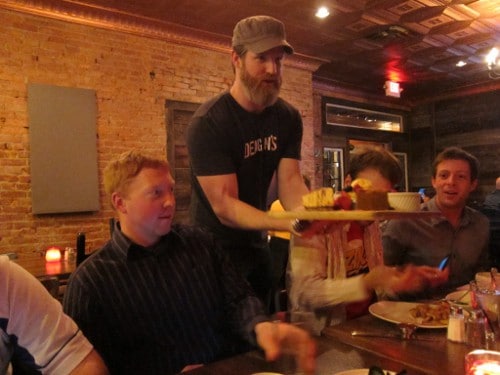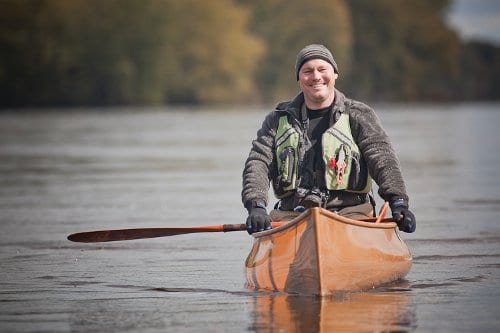
Training Gary Matthews Jr. for his MLB comeback.
Once again we return to our So You Want My Job series, in which we interview men who are employed in desirable jobs and ask them about the reality of their work and for advice on how men can live their dream.
You’re a guy who’s passionate about health and fitness, and you want to make that passion a career. You’ll probably start out being a trainer, working with clients at someone else’s gym. But after years of that, you might want to take it to the next level and create an environment you completely design and run yourself. By opening up your own gym.
That’s what Brad Davidson did. After gaining experience as a trainer, Davidson opened up his own gym: Stark in Orange County, California. Today he shares his advice on how he’s turned his dream into a premier gym for high-level athletes and clients.
1. Tell us a little about yourself (Where are you from? How old are you? Describe your job and how long you’ve been at it, etc.).
I was born in Honolulu, HI, where my father was stationed in the Navy, and then spent my childhood growing up in McMinnville, Oregon. I am 36 years old. I am co-owner and Head LEAN Braniac at Stark–“The Coolest Little Gym in America”–located in Irvine, CA. My job consists of developing results-oriented training, diet, and lifestyle programs for successful business men and high-level athletes who want to get lean and enhance their competitive edge with optimal performance. I’ve been enhancing the lives of executives and athletes for the past 13 years.
2. Why did you want to become a gym owner? When did you know it was what you wanted to do?
I’ve been fascinated with weight training ever since my dad bought me my first weight set and taught me how to lift weights in my room when I was in 6th grade. The fascination stuck through high school when I tried using weights to give me an athletic advantage when I was small compared to my competition. By the time I was in college playing sports, I began to quickly see the shortcomings in our strength coaches from all my own studies. I remember arguing with a professor in an Exercise Physiology class about a theory I knew didn’t work in the real world through trial and error. That was the day I knew I was going to dedicate my life to enhancing others through health and fitness. I wanted to help people squeeze the most out of life with proven methods–not these ridiculous theories that are still running the commercial gyms today.
3. I imagine that starting a gym comes with many of the same considerations as opening other kinds of businesses—finding a location, getting a loan, etc. Are there any considerations unique to opening a gym that would-be gym owners should know about?
The most important thing I think would-be gym owners should be cautious of is going big too soon. I am a true believer in starting small and growing to the point of blowing out your seams before opening a larger location. There is going to be growing pains, and the only reason we survived was by maintaining a low enough overhead to make it through those times. I see it over and over–a trainer opens an amazing gym but doesn’t have the business to support it and the clients don’t show up soon enough, leading to an inability to cover the overhead.
4. Here where I live, it seems like a lot of the independent gyms started by trainers and bodybuilders open and then close relatively quickly due to mismanagement, while one of the most successful independent gyms is owned not by a fitness guy, but someone who also owns a bunch of restaurants. What’s most important in running a successful gym—fitness experience and enthusiasm, or business savvy?
I hate to say it, but you can be the greatest mind in the fitness industry but if you don’t possess business savvy you are doomed! This is where a majority of gym owners go wrong–they have no real clue how to run a business. I’ve notice most high-level trainers (this included myself years ago) think we know everything there is to know about running a business because we have read all the books on it, but I got lucky and partnered up with a great business man after barely surviving for 5 years, and it was amazing the difference it made in our success. Funny thing was the first 6 months of changes were strictly business stuff (cash flow management, proper pricing etc.), and yet we doubled our bottom line in that 6 month period without adding any new clients.
5. What are the keys for successfully competing against the big gym chains?
To be successful against the big gym chains I believe you must have a niche and you must produce results! Our niche is enhancing high-level executives and athletes by getting them lean first and providing a competitive edge in their careers. We measure and monitor everything they do every month. We are paid to get a result and we get the result!

Training Olympic Hopeful Ryan Mertens, USA Bobsled Pilot
6. What’s a typical day like for you?
My days are long and start early, but it truly is what I love doing in life. I get to play with my passion all day every day, and I am now surrounded by the who’s who of Orange County. I usually train clients from 5:30 am to 1 pm and will mix my own workout in there somewhere. I have lunch at 1 pm and then spend my afternoons studying ways to get clients more efficient results and overseeing the development of all our clients’ program layouts. My main role is to make sure everyone in our system is progressing and the team we have constructed–which is actually scattered throughout the world–does an amazing job meeting each client’s individualized needs and desires.
7. What is the best part of your job?
Best part of my job is watching people’s lives transform. There is nothing better than watching someone look, feel, and perform at a level they never dreamed possible. It’s also really cool to watch men enhance their lives at a deeper level; they become better fathers, husbands, employers etc. from being through our program.
8. What is the worst part of your job?
Worst part of my job is the focus on detail and paperwork. Detail is the major difference between great client results and meager results. It has to be done, but that doesn’t mean I have to like it. :)
9. What is the work/family/life balance like for you?
Work/ family/ life are very easy to get out of balance with this career. I’ve really had to put a lot of effort into this area now that I am married with kids. It is very easy for me to get swept away with research and trying to meet our clients’ needs. I have forced myself to leave the office every night by 6:15 pm to give my kids plenty of dad time and my wife relationship time. I also have forced myself to not check my phone or email once I pick up the kids until after they go to bed. The funny thing is I actually get more work done with time restraints than I ever did working crazy hours.
10. What is the biggest misconception people have about your job?
To be honest I hate telling people I am a trainer–they immediately throw me into this stigma of meathead womanizer. I know the majority of male trainers at the large commercial gyms use their role as trainers to meet women, but there is a small group of us that really take pride in what we do. My family’s livelihood depends on my gym’s ability to change people’s lives. There is a lot at stake when a client walks into my gym. Some of us take your health very seriously!
11. Any other advice, tips, commentary or anecdotes you’d like to share?
This career is incredibly rewarding but is very hard to stand out in. Be patient and do whatever you have to do to stand out from the crowd. You walk into most gyms and you will see the same things going on. Be different and you will be noticed. Get results and you will be noticed. I am a true believer that one of the things we do well that helps us stand out is the use of technology. Most trainers don’t document anything they do with their clients. We not only document everything a client does, we have it all built into a cloud system and we use iPads. So the first thing you will notice at our gym is all our trainers walking around documenting sets, reps, and weights with iPads. This is a very simple use of technology and an incredible way to stand out.
Tags: So You Want My Job







